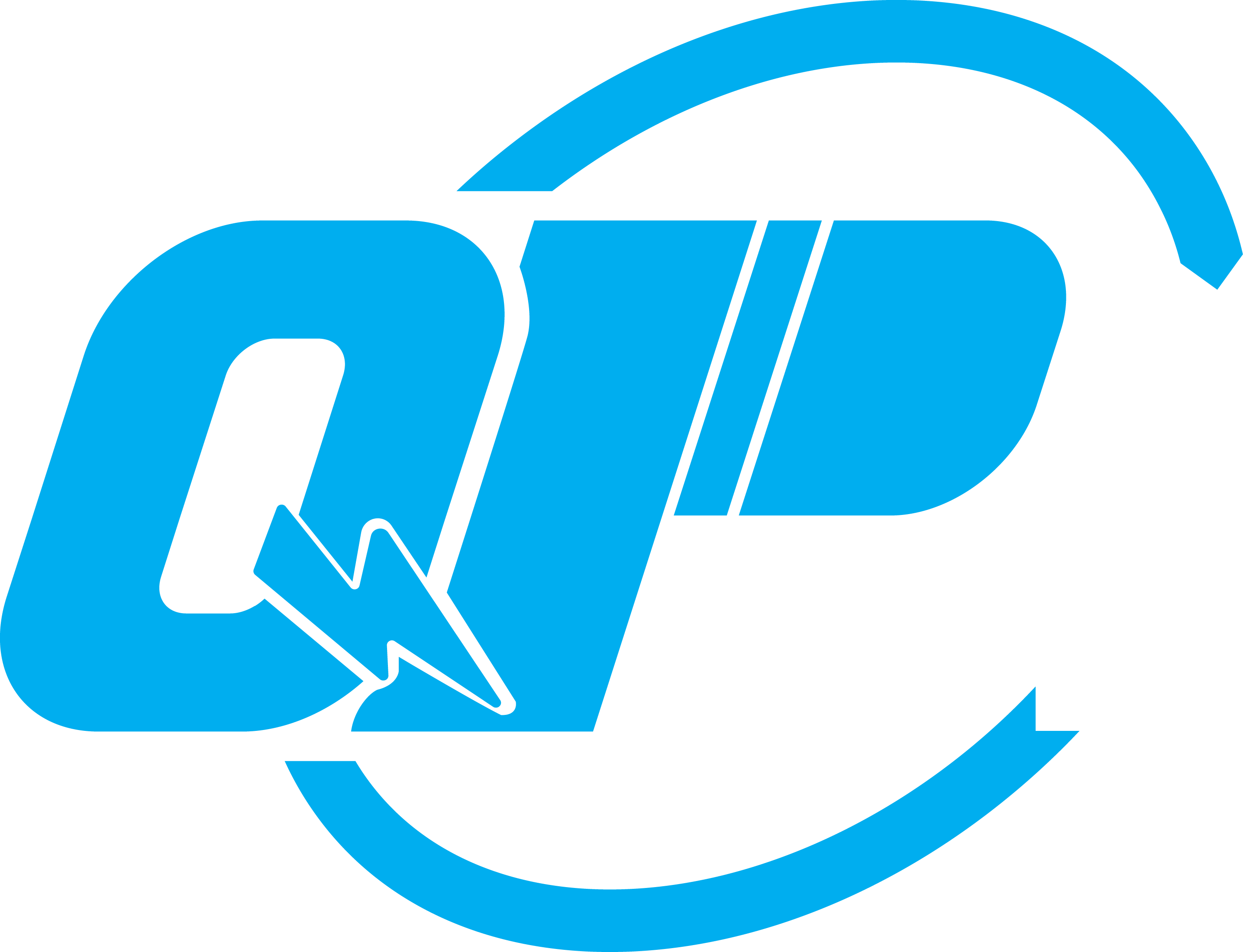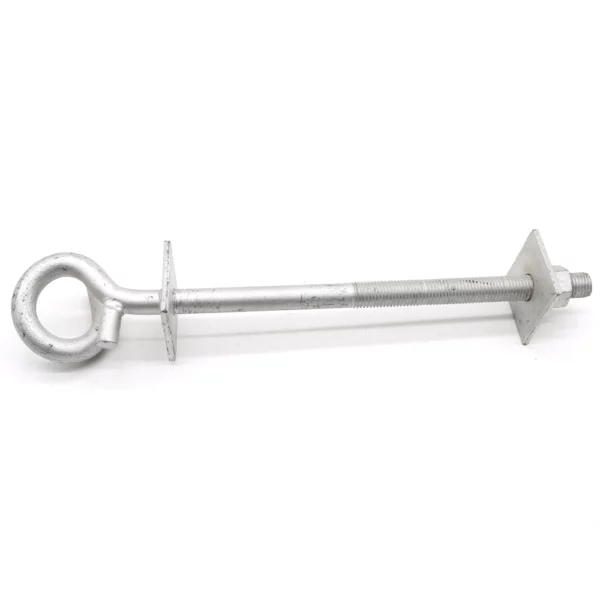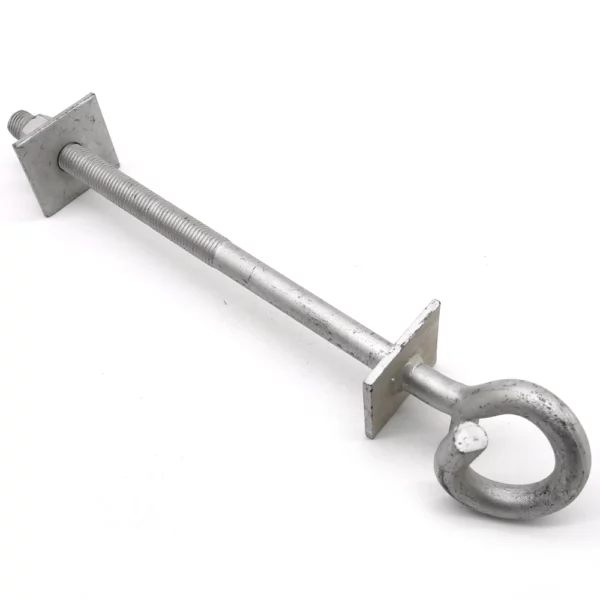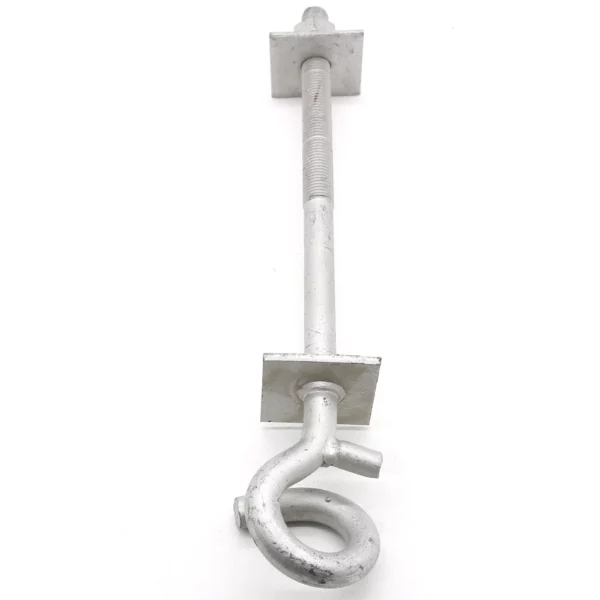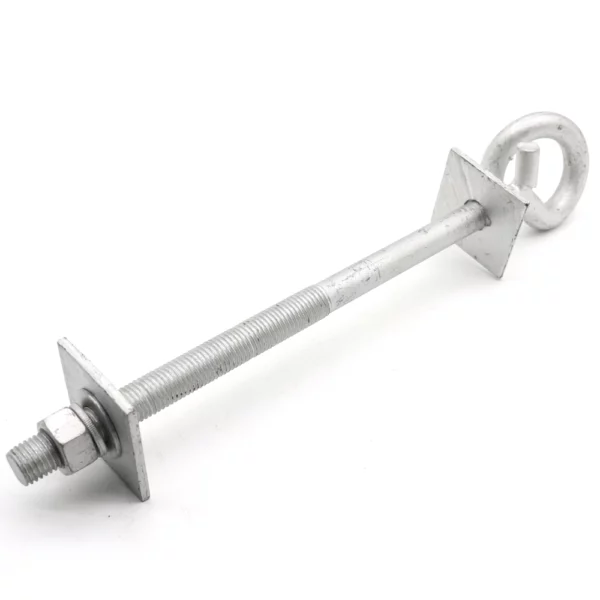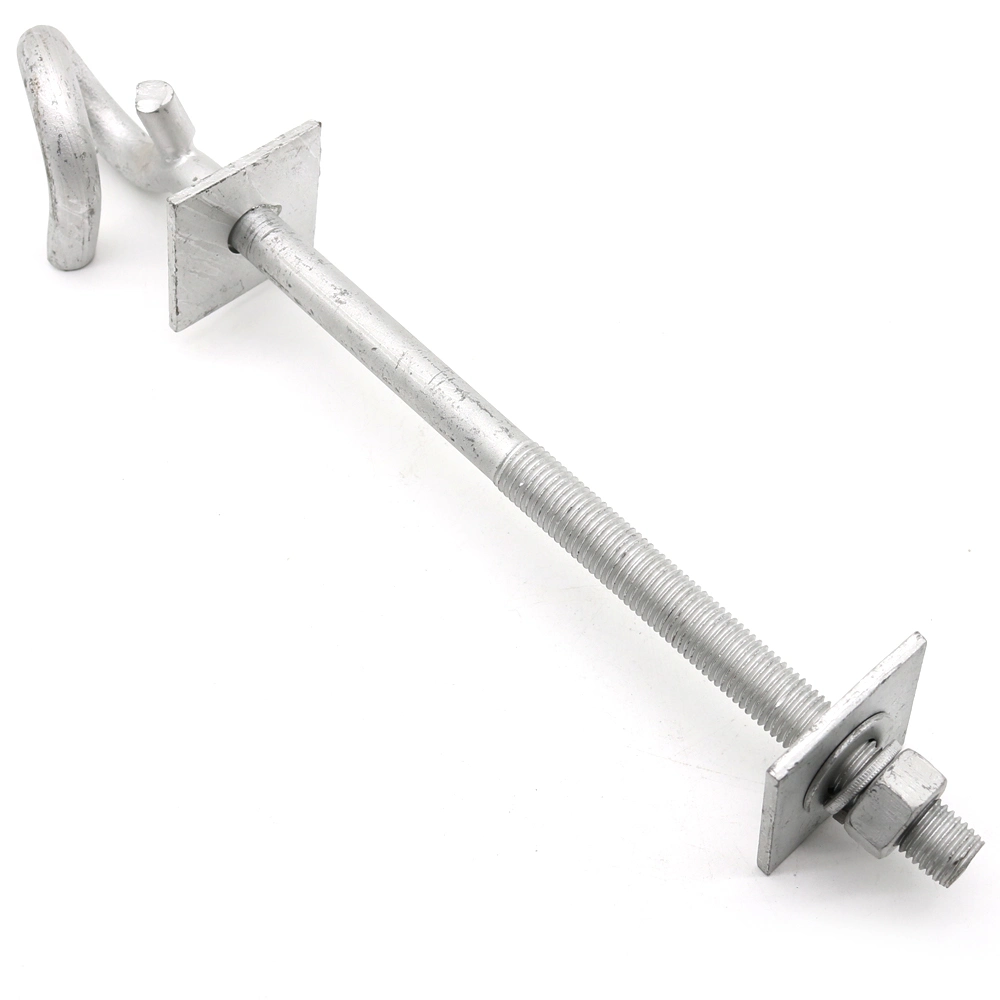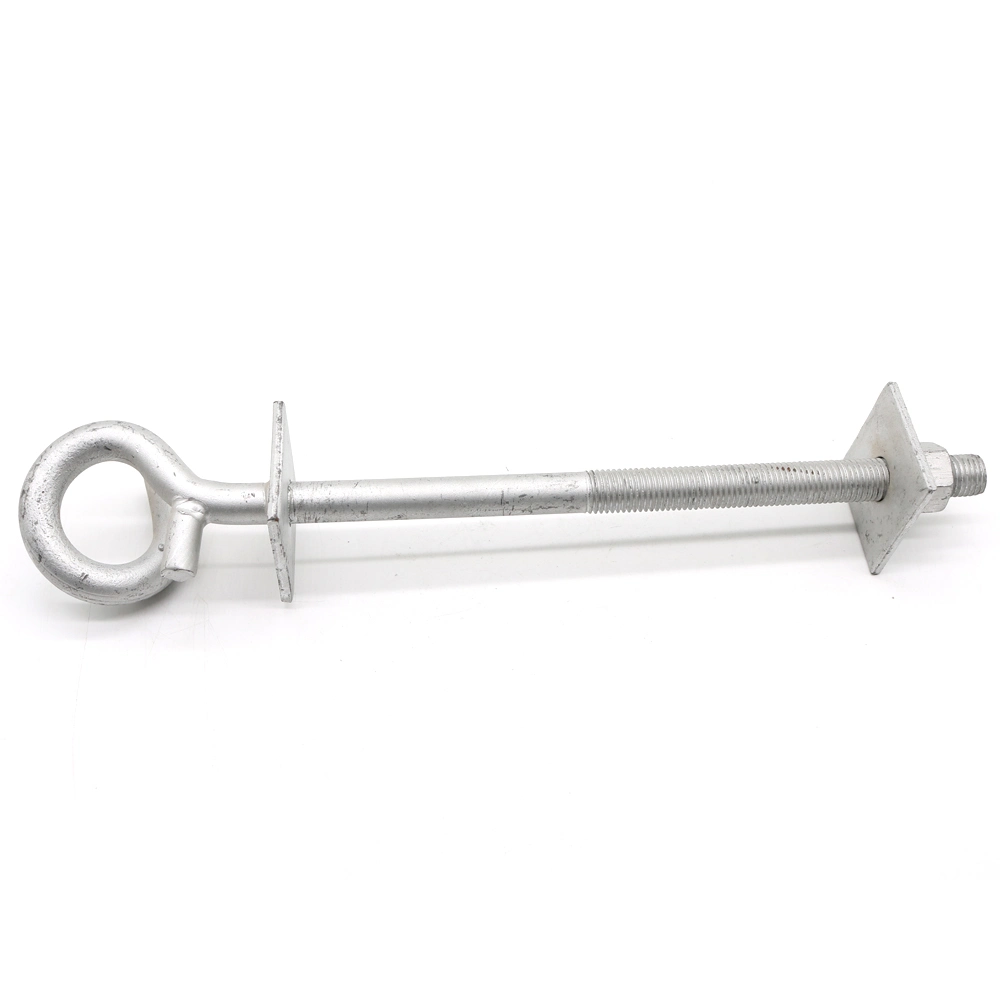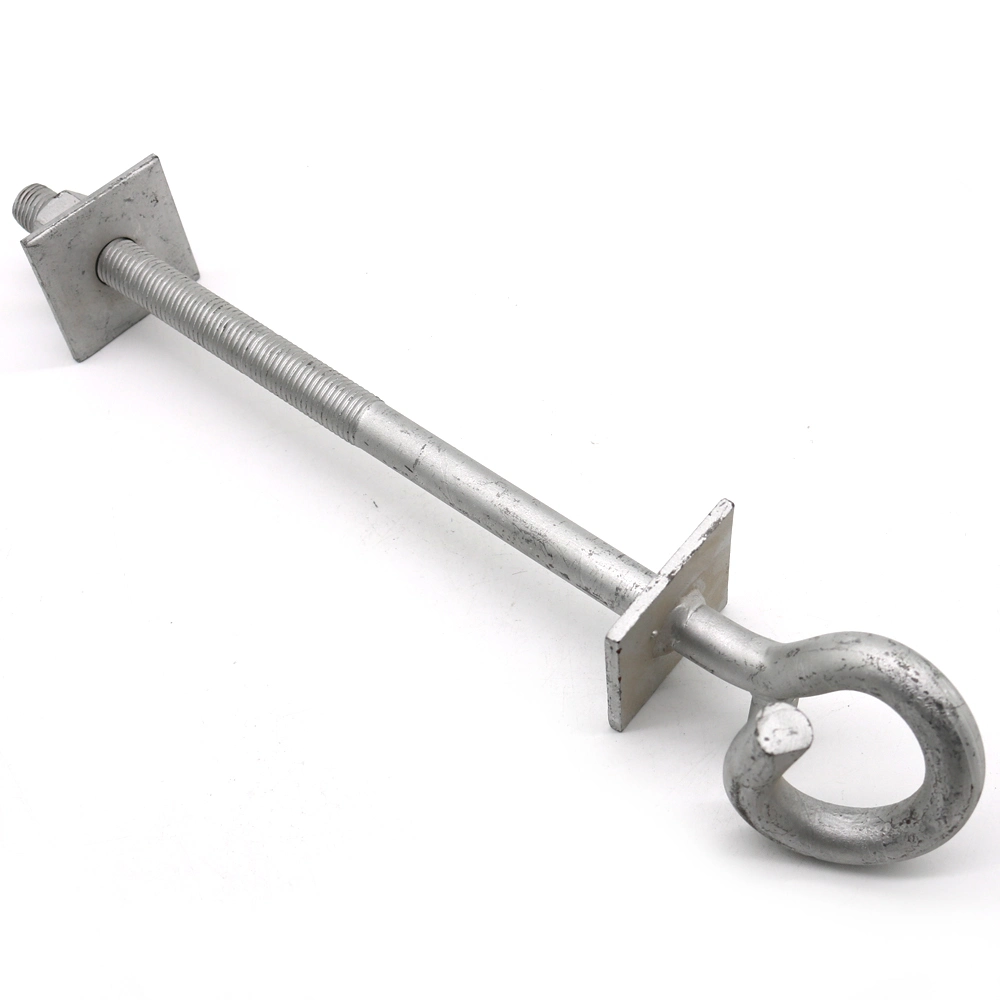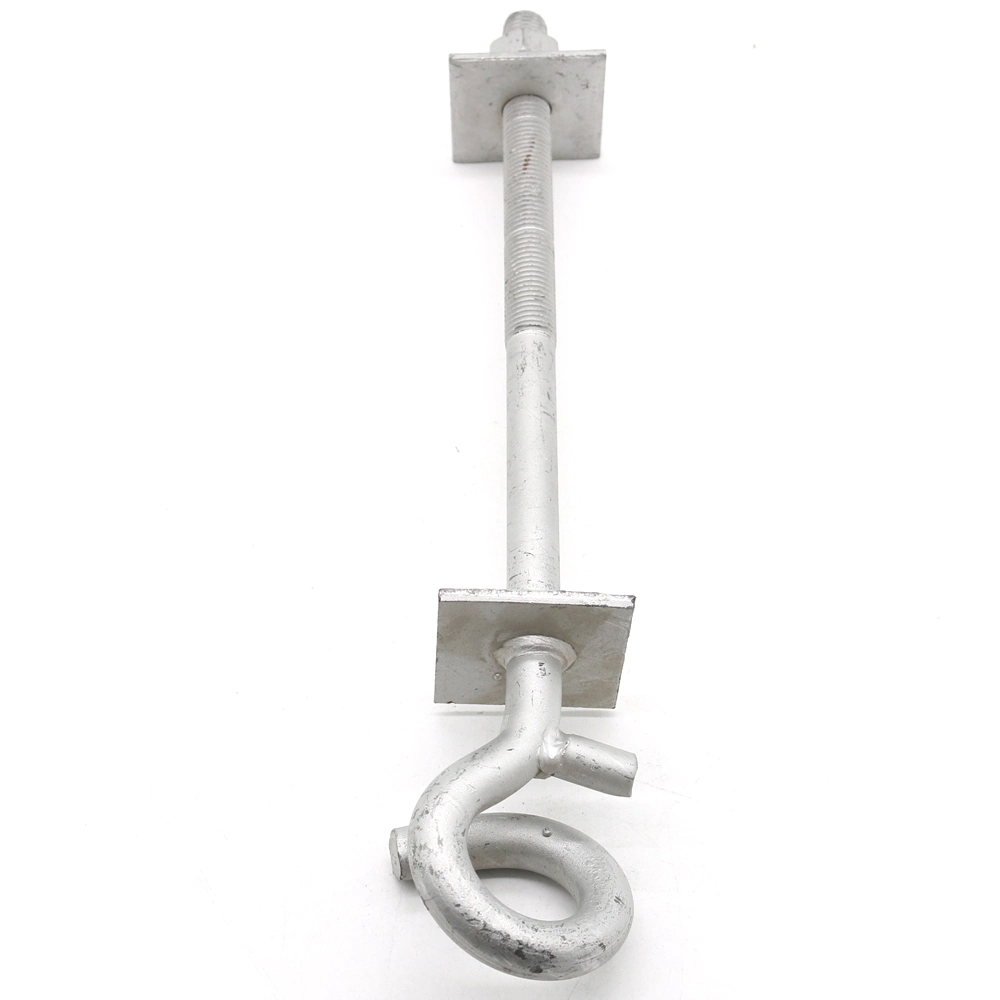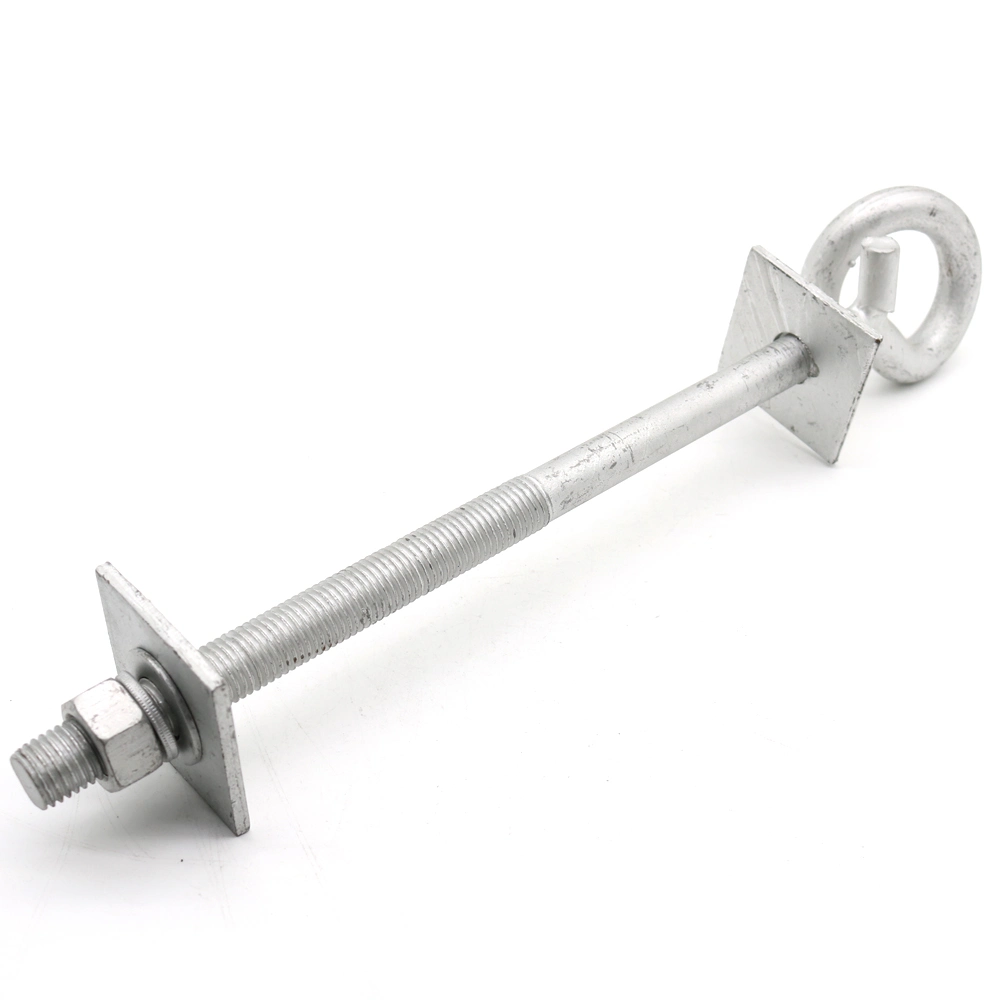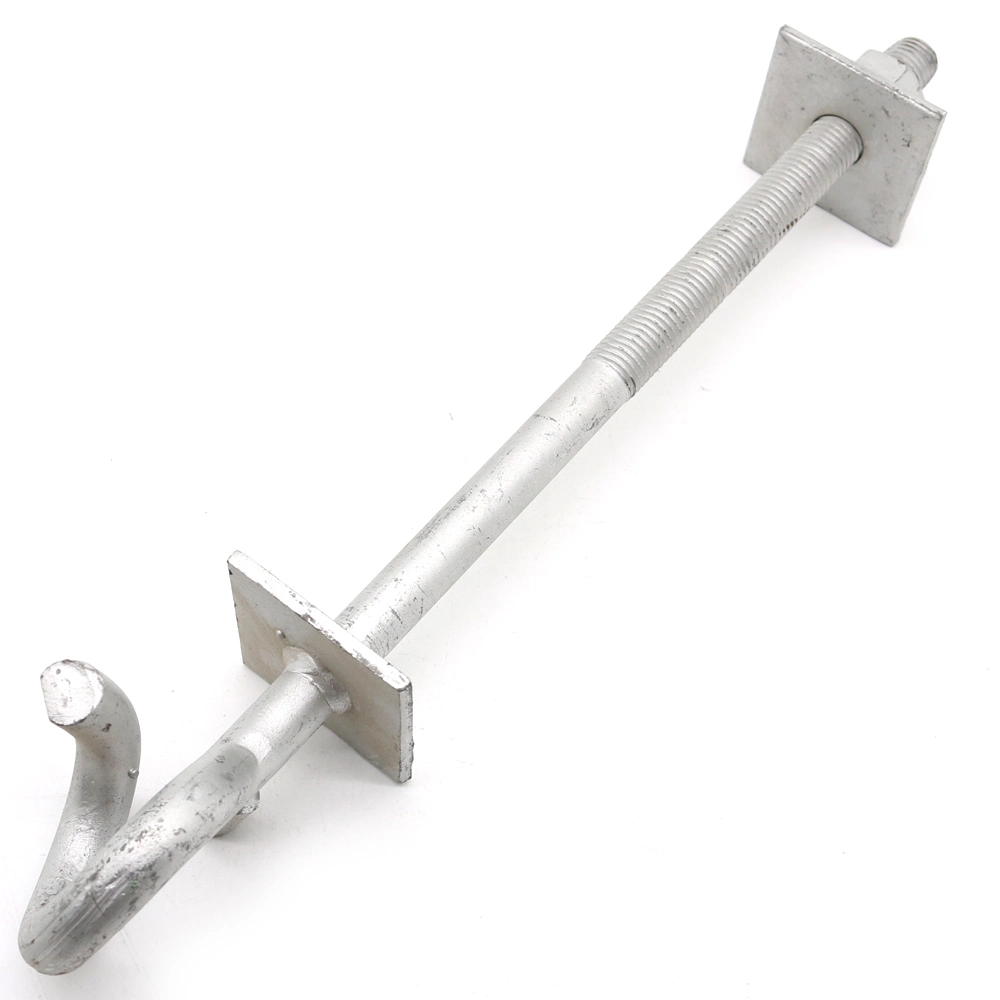Pigtail Bolt
- Description
Description
Pigtail bolt is also called pigtail eye bolt, pigtail hook, pigtail screw, pigtail hook screws, pigtail fastener, it’s one kind of pigtail hardware.
Quan Pham Industry pigtail bolt is designed for use on wooden poles, concrete or other power line poles to hang the dead end clamp or suspension clamp. Because the helical end of the pigtail bolt is like the “ pigtail”, so it was called a pigtail bolt or pigtail hook.
The pigtail bolt does not have the same shape and structure. The pigtail bolt used in Kenya and Zambia is a welded square washer or round washer on the neck of the pigtail hook. The pigtail bolt used in Malaysia has two extra forged points, on the left and right sides of the neck pigtail hook. This design prevents the washer from dropping off.
The complete set of a pigtail hook usually includes one piece of pigtail hook main body, two hex nuts, and two washers.
When the pigtail screw is installed on the wooden pole or concrete pole, the hex nuts and washers are used to fasten the end on one side of the pole. The other pigtail end is used to link the suspension clamp.
There is also a pigtail bolt without a screw, it’s only with a round end.
Compared to other pigtail eye bolt manufacturers, Quan Pham Industry delivers a large variety of pigtail eye bolt designs to end-users, from varying rod diameter, thread length to structures. Quan Pham Industry eyebolts are ideal for electric transmission, communication lines, and train lines.
If you have any inquiries, please contact us.
Table of Contents
- 1 Pigtail Eye Bolts: The Ultimate Guide for Importers
- 2 What is a Pigtail Bolt?
- 3 Benefits of Pigtail Bolts
- 4 Applications of Pigtail Hook Screws
- 5 Main Components of Pigtail Bolts
- 6 Technical Specification of Jingyoung Pigtail Bolts
- 7 Pigtail Bolts Manufacturing Process
- 8 Step-by-step-Pigtail Bolt Installation Process
- 9 Frequently Asked Questions (FAQs)
- 10 Conclusion
Pigtail Eye Bolts: The Ultimate Guide for Importers
Pigtail bolts are among the primary fasteners in pole line transmission and distribution lines.
You will need a pigtail eye bolt when installing most pole line hardware.
But, how do you find high quality, durable and reliable pigtail eye bolt?
In this guide, you will learn everything you need to look for – design, technical specifications, best material, etc.
Let’s get to that.
What is a Pigtail Bolt?
Pigtail eye bolt is used in concrete, wooden, and other power posts for receiving aerial bundled cable across suspension clamps and dead-end clamps.
Pigtail bolt
These bolts have one end threaded for fitting an expansion component.
The other end is hot worked to make a pigtail for the hanging of chain type handrails, electrical and telephone cable as well as air, refrigeration, water, and ventilation columns.

Pigtail bolt
Benefits of Pigtail Bolts
Now, some of the main benefits of installing pigtail bolts include the following:
· Easy installation
For its installation, pigtail hook screws do not need a specific procedure.
This implies you can quickly put it into use immediately after its installation.
It performs its function without particular equipment or process.
· Use of simple tools
Possibly this is among the most essential advantages of using pigtail eye bolts as connectors.
It does not need distinct tools that call for know-how by a few.
· Accommodates minor measurement variations
Pigtail screws can integrate minor measurement differences.
The dimensions do not have to be precise in the event of slight dissimilarities in between.
· Immediate support
After attaching and tightening the pigtail bolt, it immediately holds the load irrespective of its weight.
· Negligible deformation
The bolts experience very insignificant buckling over time.
Applications of Pigtail Hook Screws
As I have stated already; you can use pigtail eye bolts for suspension of ventilation, air, refrigeration, and water columns as well as chain type handrails and telephone and electrical cable.

Pigtail hook screw
Using them for heavy duty applications such as supporting platforms and snatch block rigging is not advisable.
Main Components of Pigtail Bolts
The complete kit of pigtail hook is normally composed of:
- Single piece of pigtail bolt main body
- Two hex nuts and
- Two washers

Parts of pigtail bolt
There also exist some types of pigtail eye bolts without screws, they have a circular end.
· Threads
All threads formation is through a cold-rolling process, with the pigtail eye created by hot forming to boost its mechanical features.
Metric (right hand only) – M20 x 2.5 – 8g and M16 x 2 – 8g are the standard types of threads available.
However, the pigtail hook screws do not have similar shapes and structures.
Those widely used in Zambia and Kenya have circular or square washers welded on the bolt’s neck.
The commonly utilized pigtail hooks in Malaysia have two additional forged points on the right and left sides of the bolt’s neck.
This design type hinders the falling off of the washer.
Technical Specification of Jingyoung Pigtail Bolts
We provide our customers with pigtail bolts in several designs, from varying thread length, rod diameter to structures.
We manufacture our pigtail hooks using steel, and further hot forge them to promote high breaking strength necessary in overhead conduit connection.
Our pigtail eye bolts come in varying configurations as this table shows.
Measure the length to below the twist.


Pigtail Bolts Manufacturing Process
We may have bolts in differing sizes and shapes though; the manufacturing process predominantly remains similar.
 Pigtail bolt technical drawing
Pigtail bolt technical drawing
It begins with cold forging steel wire into an appropriate design, followed by heat treating to enhance strength.
The bolt then undergoes surface treating to boost longevity before packaging for shipment.
Even so, for more advanced models of bolts, such as pigtail eye bolts, the fabrication procedure can include several extra steps.
At Jingyoung, we do not manufacture catalog components – everything we create is tailor-made, following the customer’s specifications.
Depending on the environment you are going to use the fastener, we have a variety of alternatives for producing precisely the correct bolt.
Cold Forging
The process commences with uncoiling and cutting to length large steel wire rods.
The requirements of ISO 898-1 have standardized the grade of steel throughout the industry.
You could forge the wire into the necessary shape by employing specialty tooling.
This is primarily where moulding of the steel takes place, while under room temperature, through thrusting it via a sequence of dies at enormous pressure.
The tooling fundamentally can be very complicated, constituting 200 different components with tolerances of hundredths of a millimeter.
Once you have perfected the art of cold forging, you can produce the bolts faster, in large quantities, and with great consistency.
For more sophisticated bolts design like pigtail bolts, which you cannot contour by cold forging only, you require additional twisting.
Making the pigtail hook involves turning the formed bolt at great speed while cutting away steel to attain the pigtail end design.
Heat Treatment
Heat treatment is a customary procedure for all types of bolts, which entails subjecting the pigtail fastener to high temperatures to make the steel harder.
Typically, manufacturers do threading before heat treatment, either through cutting or rolling when the steel is soft.
Rolling operates much similar to cold forging and entails passing the pigtail hook screw via die to create and cast the steel into threads.
Cutting constitutes creating threads through trimming and removing steel.
Because heat treatment will alter the features of the steel by making hardening it, it is easier and more economical to do threading beforehand.
Nonetheless, threading after heat treatment boosts the fatigue performance of the pigtail eye bolt.
The heat treatment can result in heat marks and slight damage to the pigtail screw.
Due to this fact, some individuals prefer threading after heat treatment.
It’s a more costly procedure because you should create hardened steel, yet the threads will retain their structure better.
The heat treatment may cause the steel to return to the circular shape of the first steel wire.
This happens in the case of long pigtail hooks, where the bolt is more than times longer than its diameter.
Therefore, you will need to carry out a process of straightening.
The bolt’s expected application and your requirements determine the selection of surface treatment methods.
Frequently, corrosion resistance is the main bother for fasteners.
For this reason, zinc-plated coating put by electrolytic treatment is a popular solution.
This is an operation whereby you dip the pigtail bolt in a liquid having zinc.
You then apply the electric current to enable the zinc to develop a coating on the bolt.
Nonetheless, electrolytic treatment increases the chances of hydrogen embrittlement.
Alternatively, you can use zinc flakes, which provide even higher resistance to corrosion, even though at a higher cost.

Pigtail fastener
Using phosphate is a more economical alternative when resistance to corrosion is not a bother.
After applying the surface treatment, standard pigtail screws are typically ready for packaging.
Though, more advanced models may need some extra assembly like brackets.
Some may as well require a certain kind of patching, either a liquid or locking patch.
A locking patch constitutes a dense nylon coating over the threads, which aids in enhancing grip.
A liquid patch assists in boosting thread-forming torque.
The pigtail eye bolts are ready for use after going through these steps.
Before packaging and eventual shipping, the bolts go through quality control to establish conformity and consistency.
The Production Process Summary
- Uncoiling, straightening and cutting the wire to length.
- Cold Forging: Forming the steel into the desired design at room temperature.
- Pigtail end: Turning the bolt at high speed while twisting to obtain the pigtail design
- Threading: Forming of threads is through cutting or rolling.
- Heat Treatment: Hardening the steel by subjecting it to extreme heat.
- Surface Treatment: Dependent on the use. Zinc plating is popular to boost corrosion resistance. Jingyoung surface treats its pigtail eye bolts by hot-dip galvanization according to ISO1461.
- Packing/Stocking: Packaging of the bolts after quality control to check uniformity and consistency.
Step-by-step-Pigtail Bolt Installation Process
You mostly use bolts to lock two or more items together via pre-drilled holes.
Washers help in reinforcing the connection by diffusing the force exerted by the pigtail bolt over a larger space.
Special washers are also there, for instance, lock washers, which assist in preventing coincidental unfastening of the pigtail screw.

Installing pigtail bolt
Pigtail eye bolt aids in the fixing of suspension assemblies to the concrete or wooden pole.
Its installation is straightforward, driving it through a pre-drilled hole and fastening it with a nut.
After installing the pigtail hook screw on the concrete or wooden pole, you use the two hex nuts and washers to tighten one end to the post.
The remaining pigtail end is where you connect the suspension clamp.
Pigtail hook has two nuts threaded onto it to fasten the joint, and similar to washers; they come in different kinds for a variety of uses.
The type used with pigtail bolts is hex nuts.
Step 1
Establish the right size and type of nut, washer, and pigtail hook for your operation.
The choice is dependent on the kind of connection you are working on, the bolt strength, standards, and rules for the application among other factors.
Step 2
Insert the first washer on the pigtail bolt’s shaft.
You will add a lock washer if needed then follow it with the second washer.
Step 3
Push the pigtail hook screw through the hole, ensuring that you firmly press the first washer between the bolt neck and the pole.
Step 4
Insert the second washer on the part of the pigtail eye bolt that is protruding out from the pole.
Step 5
By twisting clockwise, thread the two hex nuts onto the pigtail fastener shaft.
Make sure the first nut presses on the washer by hand-tightening it.
Step 6
Using the correct size of a wrench, fasten the nuts tightly against the washer, but do not overtighten.
Frequently Asked Questions (FAQs)
What is a pigtail bolt?
A pigtail bolt is one kind of pigtail hardware that is used in concrete, wooden, and other power posts for receiving aerial bundled cable across suspension clamps and dead-end clamps.
It is also called a pigtail eye bolt, pigtail hook, pigtail screw, pigtail hook screw, or pigtail fastener.
What is the difference between pigtail bolt and pigtail screw hook?
There is no big difference between pigtail bolt and pigtail screw hook, just difference on the end. The pigtail screw hook is usually with a sharp end.
What is the manufacturing process of pigtail bolts?
- Uncoiling, straightening and cutting the wire to length.
- Cold Forging: Forming the steel into the desired design at room temperature.
- Pigtail end: Twisting to obtain the pigtail design
- Threading: Forming of threads is through cutting or rolling.
- Heat Treatment: Hardening by subjecting it to extreme heat.
- Surface Treatment: Hot-dip galvanization according to ISO1461.
- Packing/Stocking
What is the benefit of pigtail bolts?
- Easy installation
- Use of simple tools
- Accommodates minor measurement variations
- Immediate support
- Negligible deformation
Conclusion
Working with the pigtail eye bolt and washers may seem very simple.
They only have one application: fastening and connecting objects.
With this guide, I am sure you know the critical aspects of pigtail eye bolts.
Whether you want to manufacture or use one for your applications, this guide gives you all the critical information.
Here at Jingyoung, we design and manufacture high-quality pigtail eye bolts.
Talk to us today for competitive prices on pigtail bolts.
